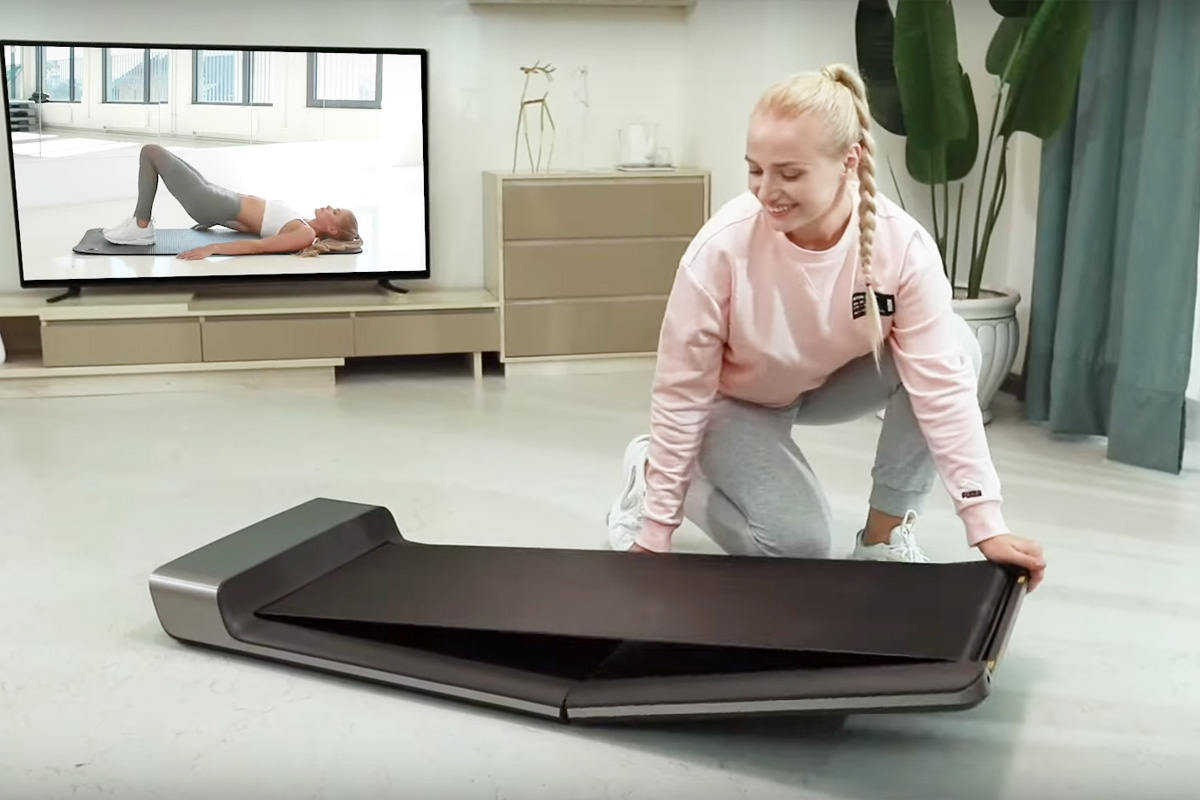Have you ever wondered if you can walk your way to fitness right from the comfort of your living room? Well, here’s something that might have crossed your mind: using a walking pad treadmill on carpet.
It sounds simple enough, but there are things to think about before rolling out your workout gear onto that plush pile. Here’s one fact to get us started – placing a walking pad treadmill on a carpet isn’t always recommended.

We’ll cover whether this setup is doable without turning your flooring into an unhappy victim of fitness goals. Plus, we’ll toss in some handy tips and suggestions for those who want to march on with their step targets without stepping outside.
Contents
Feasibility Of Using A Walking Pad On Carpet
Thinking about putting your walking pad on carpet? It might not be as simple as it sounds. Carpets could get hurt, and the surface might make your walk feel a bit wobbly. Plus, don’t forget about the extra noise and shake—it could turn your quiet stroll into a loud adventure.
Potential Damage To Carpet
Using a walking pad on your carpet might not be the best idea. The heavy steps and constant movement can press and wear down the fibers of your carpet over time. Think about it—you’ve got this machine that’s about 4 feet long, designed to help you hit those step goals right from your standing desk or while watching TV, but at what cost to your cozy carpet? Those same features that make walking pads great for staying active without leaving the house could lead to unsightly marks or even thinning of your beloved carpet.
Noise reduction mats under treadmills often suggest a solution, but they don’t always stop the damage.
And there’s more than just the looks to worry about. If parts of the carpet get too worn out or if the surface becomes uneven because of how much you use that treadmill, tripping could become a real concern—and no one wants their fitness routine to end with an accidental face-plant into their living room floor!
Uneven Surface
Moving on from the potential harm to carpets, another hiccup with using a walking pad on them is the uneven surface issue. Carpets, especially thicker ones, don’t always lay flat and smooth.
This means your walking pad might wobble or tilt as you use it. Imagine trying to walk straight but feeling like the ground under you is shifting slightly. Not ideal, right? It’s kind of like wearing shoes that don’t fit quite right; you can do it, but something feels off.
This unsteady surface isn’t just about comfort—it could mess with your stride or balance. And since part of the appeal of a walking pad is its compact size—about 4 feet long—you’d think fitting it on any carpet would be easy-peasy.
But if that carpet has lumps and bumps, your quick stroll could turn into a balancing act. Keep in mind these pads are designed for folks up to 265 pounds moving at speeds up to 4 mph—that’s plenty of force needing stable ground! So while popping your walking pad on a carpet might seem like hitting two birds with one stone (comfy underfoot plus exercise), consider how even the ground really is before taking that step.
Noise And Vibration
After talking about the uneven surface, let’s chat about noise and vibration. These little buggers might surprise you if your walking pad sits on a carpet. A soft floor, like carpet, can absorb some sound but might let vibrations travel more than you’d think.
Imagine this: You’re walking quietly in your living room, but downstairs it sounds like a mini thunderstorm. That’s because carpets don’t stop all the vibrations from reaching the floors below.
Also, while we’re focusing on making our step goals at home with our trusty QR code-ready pads—keep in mind, not all creations whisper quiet promises into our ears. So, here’s the scoop—walking pads vary in how much racket they make and how they shake things up.
Some are as subtle as a cat stalking its prey; others remind us of that one noisy upstairs neighbor we’ve all had at least once. It’s all about finding that sweet spot where comfort meets consideration for everyone else around you.
Benefits Of Using A Walking Pad On Carpet
Putting your treadmill on carpet adds a cozy twist to your workout. It lets you exercise anywhere at home and makes each step softer, which is easier on your body.
Versatility In Location
Using a walking pad on carpet lets you pick where to work out. You’re not stuck in one spot. Maybe today, you want to walk while watching TV in the living room. Tomorrow, it could be catching up on emails in your home office.
The point is, you have options – lots of them! This flexibility means more chances to hit those step goals without making big changes to your daily routine.
Flexibility in workout location can significantly boost how often we exercise, said a health expert. With a compact size of about 4 feet long and features that make some models easy for moving around, setting up your walking pad across different rooms becomes a breeze.
This way, getting in those steps or reaching that max speed of 4 mph doesn’t mean rearranging furniture every time—just unfold, plug in, and get moving wherever suits you best.
Increased Comfort
Walking on a carpet with a walking pad feels softer underfoot. This softness helps your feet feel good as you walk. It’s like the carpet and the walking pad work together to make sure your feet don’t hurt, even if you’re on it for a long time.
Think of it as adding an extra layer of cushion between you and the floor. Plus, this setup can help reduce injuries since there’s less shock hitting your legs with each step. That means more comfort for your muscles and joints.
Carpets also turn down the noise that comes from using a walking pad – no loud thumps or mechanical sounds. This quieter exercise makes it easier to keep going without getting annoyed by constant noise.
And let’s face it, anything that makes working out less of a hassle is a win in our book! So, placing that walking pad on carpet not only keeps things comfy but also keeps things quiet, making your step goal seem like no big deal at all.
Reduced Risk Of Injury
Using a walking pad on carpet can be easier on your body. The softer surface makes it less likely you’ll hurt yourself. Since the walking pad is about 4 feet long, it fits well in many places at home.
This means you’re more likely to use it often without worrying about getting injured.
Walking on a softer surface like a carpet helps your joints. It feels nicer underfoot compared to hard floors. With less stress on your knees and ankles, working toward those step goals becomes safer and more enjoyable every day.
Convenience
So, after talking about how using a walking pad on carpet can cut down on ouchies, let’s chat about how it just makes life easier. Having one of these bad boys at home means you can hit your step goals without ever leaving the house.
Think about it: no need to worry about rain or having to slap on sunscreen. Plus, with a walking pad that’s only about 4 feet long, finding a spot for it is a breeze.
The best part? You get to walk in the comfort of your own space.
Walking pads are super easy to use too. If they have a top speed of 4 mph and hold up folks who weigh up to 265 pounds, they’ve got most of us covered. And because you’re walking on carpet—which feels way softer—your feet will thank you.
Who said getting those steps in had to be tough?
Considerations For Using A Walking Pad On Carpet
Thinking about using a walking pad on carpet? It’s not as simple as just plopping it down and starting your walk. You’ve got to think about the kind of carpet you have, maybe add a rubber mat underneath for stability, pick out the right shoes, and keep an eye on how fast or heavy you go.
These little tweaks can make all the difference in having a smooth walk or ending up with a bumpy ride.
Choosing A Thin Carpet
For your walking pad, picking a thin carpet is smart. Thick carpets make the surface bumpy and can harm your machine. Imagine trying to walk on a soft beach – not so easy, right? A thin carpet makes sure the surface under your walking pad is stable.
It helps keep things smooth for a better walk.
Also, thin carpets won’t trap as much heat from your walking pad. Machines like these can get warm with use. If you have a thick carpet underneath, it might hold too much heat. This isn’t good for the carpet or the machine over time.
So, going with something thinner will help air flow better and keep everything cooler.
Using A Rubber Mat
Slip a rubber mat under your walking pad to keep it from moving around. This simple step can help avoid damage to both the carpet and equipment. The mat makes cleaning easy too. Just lift it up, and you’re done! It also cuts down on noise, making your workout quieter.
Make sure the mat is large enough for the 4-foot-long walking pad. A right-size mat stops the edges from curling up, which could trip someone. Check that the material can handle up to 265 pounds so your walking pad stays safe and secure during use.
Proper Footwear
So, you’ve got your rubber mat down. Next up is picking the right shoes for walking on that pad. Good shoes make a big deal here. They need to grip well so you don’t slide off. Imagine trying to keep your balance if your feet are slipping every which way—not fun!
Choose shoes with a solid grip and support. Your feet will thank you, especially since they’re hitting the same spot over and over again on that walking pad. And let’s not forget about comfort; it’s key for those longer walks or when pushing yourself a bit more than usual.
Think of these shoes as your trusty sidekick in reaching those step goals without stumbling—or worse, hurting yourself because you weren’t geared up right. So take a moment before stepping onto that carpeted walkway to lace up some proper footwear.
It might just be what stands between an ok workout and a great one!
Weight Capacity And Speed Range
Walking pads are great for getting steps in at home. They have a weight limit of 265 pounds. This means many people can use them safely. When picking out a walking pad, it’s smart to look at how much you weigh and make sure it fits within this limit.
These machines also go up to 4 mph. That’s fast enough for a brisk walk but not running. Consider how fast you want to walk when choosing one. A speed that feels right makes your walk more enjoyable and effective.
Take The Next Step
So, can you use a walking pad on your floor covering? Absolutely. With smart choices like thin carpets and rubber mats, you make it work better. Think about slipping on proper shoes too, and keep an eye on the treadmill’s weight limit and speed.
Why not give it a try? After all, who doesn’t love the sound of hitting step goals from the living room? stepping onto your exercise carpet could be your next big move to staying active at home.
Ready to take that step?


